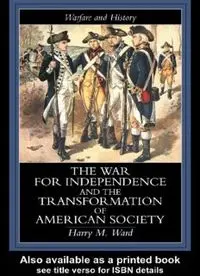
War for Independence and the Transformation of American Society PDF
Preview War for Independence and the Transformation of American Society
The War for Independence and the Transformation of American Society Warfare and History General Editor Jeremy Black Professor of History, University of Exeter European Warfare, 1660–1815 Jeremy Black The Great War, 1914–18 Spencer C.Tucker Wars of Imperial Conquest in Africa 1830–1914 Bruce Vandervort German Armies: War and German Society, 1648–1806 Peter Wilson Ottoman Warfare, 1500–1700 Rhoades Murphey Seapower and Naval Warfare, 1650–1830 Richard Harding Air Power in the Age of Total War John Buckley Frontiersmen: Warfare in Africa since 1950 Anthony Clayton Western Warfare in the Age of the Crusades, 1000–1300 John France The Korean War Stanley Sandler European and Native American Warfare, 1675–1795 Armstrong Starkey Vietnam Spencer C.Tucker Warfare, State & Society in the Byzantine World, 565–1453 John Haldon Soviet Military System Roger Reese Warfare in Atlantic Africa, 1500–1800 John Thornton The War for Independence and the Transformation of American Society Harry M.Ward University of Richmond, Virginia First published 1999 in the UK and the USA by UCL Press 11 New Fetter Lane, London EC4P 4EE The name of University College London (UCL) is a registered trade mark used by UCL Press with the consent of the owner. This edition published in the Taylor & Francis e-Library, 2004. UCL Press is an imprint of the Taylor & Francis Group © Harry M.Ward 1999 All rights reserved. No part of this book may be reprinted or reproduced or utilised in any form or by any electronic, mechanical, or other means, now known or hereafter invented, including photocopying and recording, or in any information storage or retrieval system, without permission in writing from the publishers. British Library Cataloguing in Publication Data A catalogue record for this book is available from the British Library Library of Congress Cataloging in Publication Data A catalogue record for this book has been requested ISBN 0-203-50153-5 Master e-book ISBN ISBN 0-203-55917-7 (Adobe eReader Format) ISBN 1-85728-656-1 (hbk) ISBN 1-85728-657-X (pbk) Contents List of illustrations vii Preface ix 1 A people in rebellion 1 2 Reinventing the body politic 19 3 Loyal Americans 35 4 Constraints on liberty 49 5 Revolutionary banditti 65 6 Civilians and soldiers 81 7 Recruitment and society 99 8 Followers of the army 117 9 Non-combatants 131 10 The home front 147 11 Women and family 163 12 African Americans 177 13 Native Americans 193 14 Status and mobility 211 15 Liberty and fraternity 227 Notes 245 Index 301 v List of illustrations Figure 1 “Bostonians in Distress.” A London cartoon depicts Bostonians caged because of the closing of the city’s port in 1774. The nearly starving inhabitants are fed codfish supplied from neighboring towns. 4 Figure 2 “The Alternative of Williamsburg.” R.Sanger and U.Bennett, London, February 16, 1775. Persons signing the Association, are mindful of the barrel of tar and a sack of feathers on a gibbet. 9 Figure 3 Recruits for the British Army in America (1780). Americans (post-1776) had a similar view that enlistees for the Continental army were mostly decrepit. Engraving by Henry William Bunbury. 108 Figure 4 Mary Otis Warren (1728–1814), a poet, playwright, and historian; sister of patriot leader James Otis. Painted by John Singleton Copley (about 1763). Bequest of Winslow Warren. 171 Figure 5 Lafayette at Yorktown, 1783. Painted by Jean-Baptiste le Paon (French, ca. 1735–85). 179 Figure 6 “The Bucks of America.” Silk flag presented by John Hancock to the all Black military company for service in the Revolutionary War. 181 Figure 7 “Sketch of a Stockridge Indian serving with the American Army.” In Tustin, trans. and ed., Diary of the American War… 195 vii Preface This book assesses the impact of the War for Independence on the lives of Americans during the period of the conflict. The Revolutionary War established a nation and confirmed American identity. The ideals expounded translated into guideposts for creating a Republican society, with emphasis on citizen responsibility and the promotion and protection of opportunity for freedom and equality. If societal reform seems minimal during the immediate war period, vistas were opened for continuity in progress. While the war during its span effected political reconstruction, stirred social mobility, brought economic self- sufficiency and expansion, and fixed in the American popular culture the “Spirit of ’76,” the war also had a negative side in the oppression of dissenting and ethnic minorities, further ingraining violence as endemic to the collective consciousness of the people, hardening class lines between the poor and the more affluent, bolting down more securely the institution of slavery, and accentuating even further sectional awareness and animosity. Yet most Americans united in spirit and action at least to some degree in support for the war. Like other wars in American history, however, there was the belief that the Revolutionary conflict could be easily won, making for less than adequate backing for the war effort and dissensions and frustrations. But total victory eclipsed in memory the dissonances. Largely overlooked in perceptions of the Revolutionary War is that during the war Americans were redefining themselves while forming expectations for the future. Historians over time have searched for the meaning of the Revolution— its causes, objectives, and results. Historiography swerved from the celebratory tones of the nineteenth century to twentieth-century fathoming of the competing and conflicting forces that lay below the surface. “Progressive” historians exposed the theme of men on the make seeking to distract by a large war the underclass from their aspirations for a society ix
